Part 1
Research by Dirar Flazi
Weed! Not the fun kind, but the one that requires you to kneel down and pull it out of your garden. Unfortunately, that’s what we’re discussing next.
So, what is weed?

The term “weed” is somewhat subjective and can vary based on context and perspective. In general, a plant is considered a weed when it meets certain characteristics or criteria that make it undesirable or problematic in a particular setting. Here are some common qualifications that can classify a plant as a weed:
- Invasive Nature: Weeds often have a strong tendency to spread aggressively and outcompete other plants in their vicinity. They may have adaptive features that allow them to thrive in various conditions, making them challenging to control.
- Unwanted Growth: Weeds are typically plants that grow in places where they are not intentionally cultivated or desired. For example, a plant that starts growing in a cultivated garden, lawn, or agricultural field and is not intentionally planted there may be considered a weed.
- Competitive Impact: Weeds can have a negative impact on the growth and development of desired plants by competing for resources such as sunlight, water, nutrients, and space.
- Prolific Reproduction: Weeds often reproduce rapidly, producing large quantities of seeds or propagules, which contributes to their ability to spread and establish new populations.
- Disruptive to Ecosystems: In natural environments, some plants can be considered weeds if they disrupt the balance of the local ecosystem, outcompeting native species and affecting biodiversity.
- Disease or Pest Carrier: Certain plants can act as hosts for pests or diseases that harm crops or other plants, leading to their categorization as weeds.
- Difficult to Control: Weeds may be challenging to eradicate or manage effectively due to their resilience, adaptability, or resistance to control methods.
It’s important to note that a plant considered a weed in one context or region may not be viewed the same way elsewhere. For example, some plants labeled as weeds in a garden might have beneficial properties or traditional uses in different cultural or medicinal practices.
Ultimately, the classification of a plant as a weed depends on human perception and its impact on the specific environment or setting in which it grows. Different agricultural, gardening, and ecological contexts will influence how certain plants are categorized as weeds.
So, you may be wondering why weeds are a problem. Let’s delve into the reasons behind their impact and why managing them is essential.
Weeds are a significant problem in Australia for several reasons:
- Biodiversity Threat: Invasive weeds can outcompete and displace native plants, leading to a decline in biodiversity. They may also alter ecosystems, affecting native wildlife and insects that depend on native plants for food and shelter.
- Agricultural Impact: Weeds compete with crops and pasture for resources such as sunlight, water, and nutrients. They can reduce agricultural productivity and cause economic losses for farmers.
- Waterway and Land Degradation: Weeds can take over waterways, wetlands, and natural areas, altering their structure and function. This can result in reduced water quality, loss of habitat for native species, and increased soil erosion.
- Fire Risk: Some weed species, particularly those with high fuel loads, can increase the risk of wildfires. Invasive grasses like African lovegrass and gorse can create dense, flammable vegetation, posing a threat to both rural and urban areas.
- Health Concerns: Certain weed species, such as ragweed and parthenium weed, can trigger allergic reactions in people, leading to respiratory issues and other health problems.
- Urban Environment: Weeds can also impact urban areas, growing in gardens, parks, and along roadsides, reducing the aesthetic value of landscapes and interfering with urban infrastructure.
- Cost of Control: Managing invasive weeds requires significant resources, including labor, equipment, and herbicides. The cost of weed control can be substantial for landowners, local governments, and conservation organizations.
- Climate Change: Climate change can influence weed distributions and abundance. Changing weather patterns may favor certain weed species, leading to their rapid spread into new areas.
To combat the weed problem in Australia, various approaches are used, including biological control, chemical control, manual removal, and prevention measures like quarantine and education. Early detection and rapid response are crucial in minimizing the impact of invasive weeds on native ecosystems and agricultural lands.
Weeds in Australia can spread through various means, and some of the common ways include:
- Wind Dispersal: Many weed species produce lightweight seeds with specialized structures that enable them to be easily carried by the wind over long distances. Wind dispersal allows weeds to spread rapidly and colonize new areas.
- Water Dispersal: Some weeds have seeds that float, enabling them to be dispersed by water. Waterways, rivers, streams, and floods can transport weed seeds to new locations, including wetlands and riparian areas.
- Animal Dispersal: Weeds can hitch a ride on animals, including birds, mammals, and even livestock. Seeds can become attached to fur, feathers, or in the digestive systems of animals, which then carry them to different areas.
- Human Activities: Human activities play a significant role in weed spread. Weeds can be inadvertently transported by vehicles, machinery, and equipment. Additionally, seeds can be introduced through contaminated soil, mulch, or imported plants.
- Gardening Practices: Introducing ornamental plants or soil amendments from other regions can bring along weed seeds. Incorrect disposal of garden waste can also lead to weed spread.
- Agricultural Practices: Weed seeds can be transported in agricultural produce, soil, and machinery. Poor farm hygiene and ineffective weed control practices can contribute to weed spread within and between farms.
- Disturbances: Natural disturbances such as wildfires, floods, and landslides can disperse weed seeds, creating opportunities for weed colonization in disturbed areas.
- Bird-feeding: When birds consume weed seeds, they can pass through their digestive systems unharmed and later germinate in new locations, contributing to weed spread.
Preventing the spread of weeds requires awareness, responsible land management, and best practices in agriculture, horticulture, and landscaping. Effective weed control and early intervention are essential to minimize the impact of invasive plants on native ecosystems and agriculture in Australia.
As Australia faces unique weed problems compared to other continents due to several factors:
- Isolation and Biodiversity: Australia’s geographical isolation has led to the evolution of diverse and distinct ecosystems. When introduced non-native plants (weeds) invade these delicate ecosystems, they can have a more significant impact on native flora and fauna compared to continents with more similar vegetation.
- Introduced Species: Australia has a long history of plant introductions, both intentional and accidental. Many introduced plant species have become invasive weeds, and the absence of natural predators or competitors in their new environment allows them to spread rapidly.
- Climate Variability: Australia’s climate varies widely across the continent, from tropical to temperate and arid regions. Some weed species thrive in specific climate zones, making them highly adaptable and challenging to manage in different regions.
- Fire-Adapted Weeds: Many weed species in Australia have evolved to thrive after bushfires, exploiting disturbed areas and dominating landscapes after fire events. This can disrupt the natural regeneration of native plants and alter ecosystems.
- Agricultural Impact: Weeds pose significant challenges to agriculture in Australia. They compete with crops and pasture, reduce yields, and increase production costs for farmers.
- Waterway Invasion: Weeds often infest waterways and wetlands in Australia, threatening the health of aquatic ecosystems and affecting water quality.
- Urban Sprawl: Urban areas in Australia are also affected by weeds, with invasive species colonizing gardens, parks, and roadside areas, impacting local biodiversity and the aesthetics of urban landscapes.
While weed problems are prevalent worldwide, the unique ecology, climate, and history of plant introductions in Australia contribute to the distinct challenges faced in managing and controlling invasive plants. Efforts to combat invasive weeds require a targeted approach that considers the specific characteristics of each region and ecosystem. Integrated weed management strategies that combine biological, chemical, and cultural control methods are crucial for effective and sustainable weed control in Australia.
Various methods are used to control weeds, aiming to minimize their impact on native ecosystems, agricultural lands, and urban areas. These methods include:
- Chemical Control: Herbicides are commonly used to control weeds in agricultural settings, roadsides, and non-crop areas. Selective herbicides target specific weed species while sparing desirable plants. Non-selective herbicides can be used to clear large areas of vegetation but should be applied with care to avoid harming non-target plants and the environment.
- Mechanical Control: Mechanical methods involve physically removing weeds. This can include hand-pulling, mowing, slashing, and brush cutting. Mechanical control is effective for smaller infestations and can be used in sensitive environments where chemical use is restricted.
- Biological Control: Biological control involves the introduction of natural enemies, such as insects, pathogens, or grazing animals, to reduce weed populations. These natural enemies target specific weed species and can provide long-term control.
- Cultural Control: Cultural methods focus on altering agricultural or gardening practices to reduce weed growth. Techniques such as crop rotation, planting cover crops, and adjusting irrigation practices can help suppress weeds and promote desirable plants.
- Mulching: Mulching involves covering the soil with organic or inorganic materials to suppress weed growth. Mulches prevent weed seeds from germinating and compete with existing weeds for light and space.
- Prevention and Quarantine: Preventing the introduction and spread of new weed species is critical. Quarantine measures at borders help prevent the entry of potential invasive weeds into the country.
- Integrated Weed Management (IWM): IWM combines multiple control methods to create a comprehensive and sustainable approach to weed control. By using a combination of chemical, biological, mechanical, and cultural control methods, IWM aims to reduce reliance on a single control method and minimize the development of herbicide resistance.
- Community Engagement and Education: Raising awareness about the impacts of weeds and engaging communities in weed management efforts are essential for successful control. Education programs help individuals understand the importance of weed control and how they can contribute to managing weeds in their local areas.
It’s crucial to tailor weed control strategies to specific environments and weed species, as some methods may be more effective in certain situations than others. Additionally, ongoing monitoring and adaptive management are essential to assess the effectiveness of control measures and adjust strategies as needed.
Experts and websites will provide numerous lists of different plants considered weeds based on their classification criteria. We have national weeds, state weeds, regional weeds, and local weeds. After conducting some research, here is a list of ten invasive or unwanted plants commonly found in Australia.
Paterson’s Curse (Echium plantagineum): A highly invasive weed that competes with pasture grasses and can be toxic to livestock.
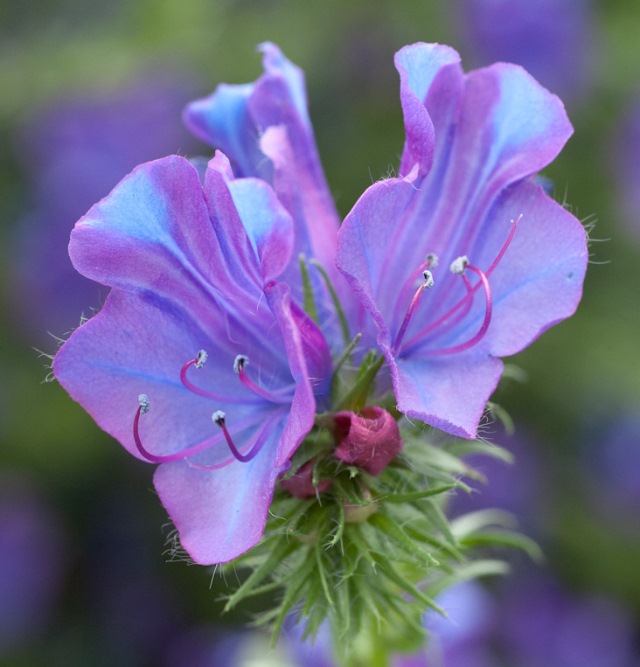
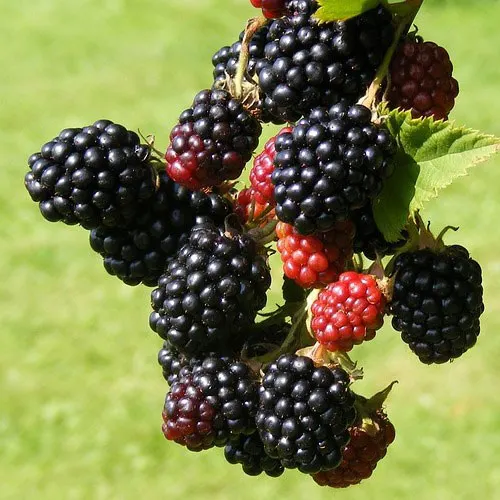
Blackberry (Rubus fruticosus): An introduced and aggressive plant that forms dense thickets, outcompeting native vegetation.
Lantana (Lantana camara): An invasive shrub with colorful flowers, spreading rapidly and crowding out native species.

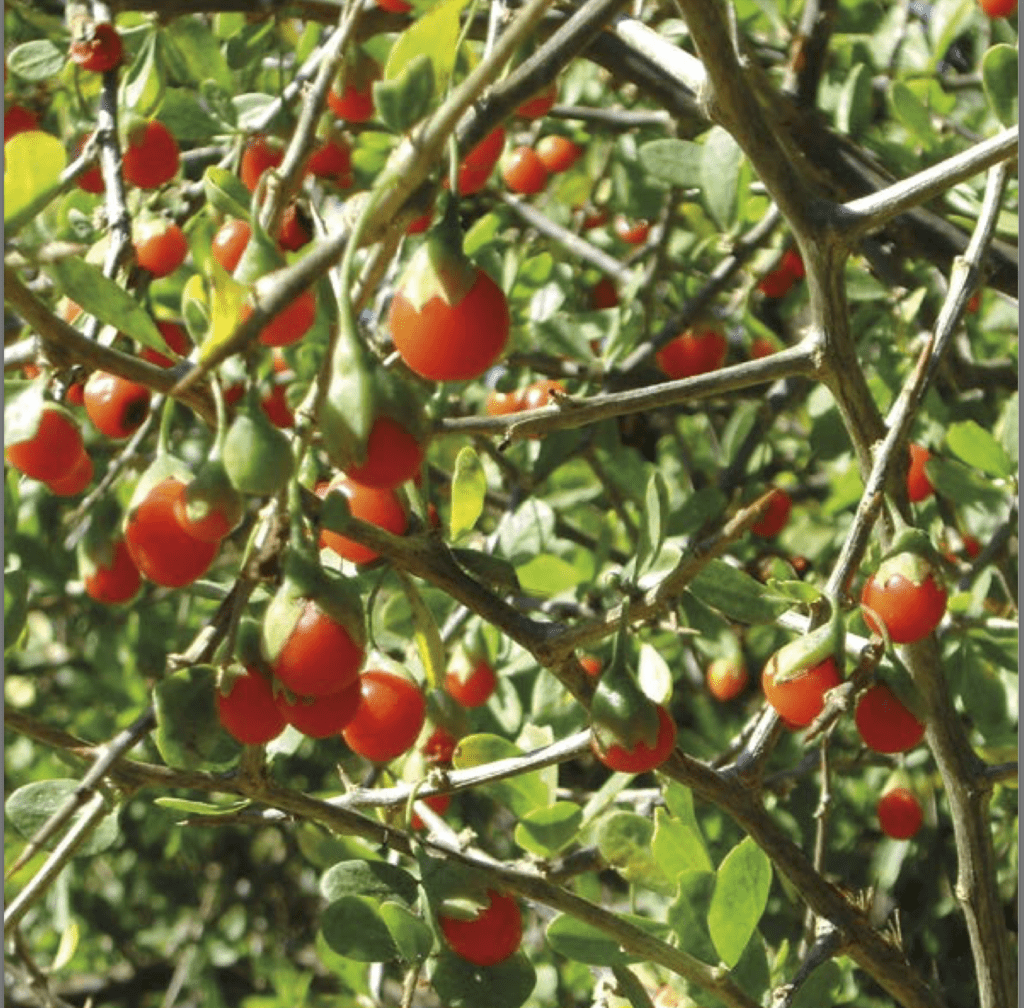
African Boxthorn (Lycium ferocissimum): An aggressive and thorny shrub that invades natural areas and agricultural land.
Madeira Vine (Anredera cordifolia): A fast-growing climbing plant that can smother and kill native vegetation.
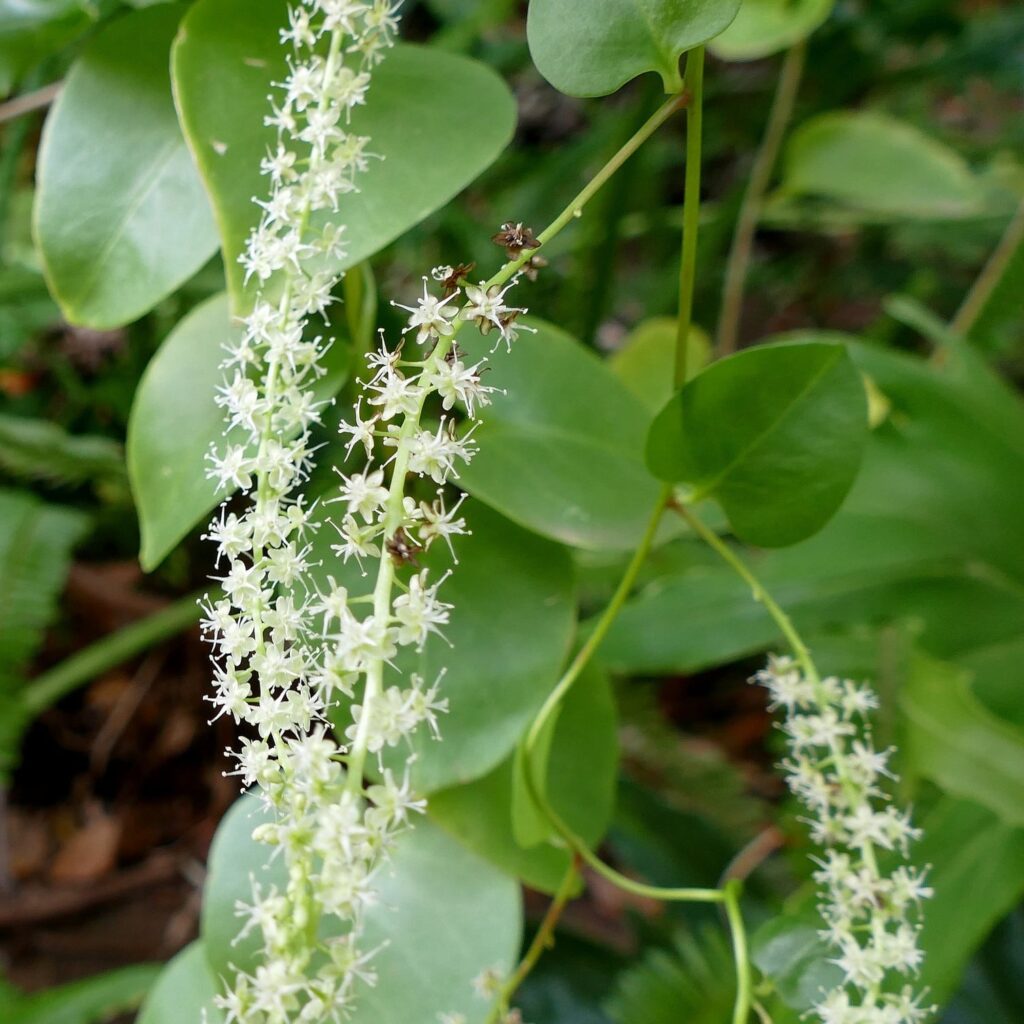

Prickly Pear (Opuntia species): Introduced cacti that have become invasive in some parts of Australia, forming dense thickets and outcompeting native plants.
Serrated Tussock (Nassella trichotoma): A highly invasive grass weed that competes with pasture grasses.

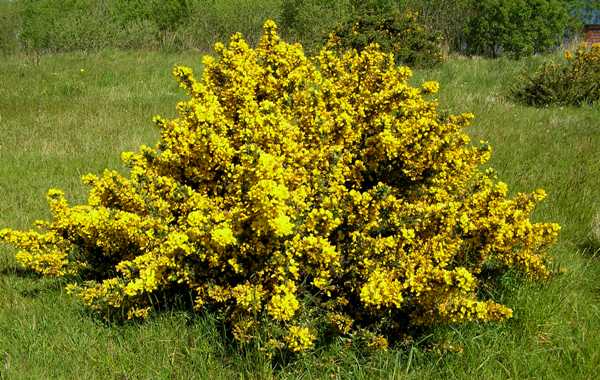
Gorse (Ulex europaeus): An invasive shrub with spiny leaves that can form impenetrable thickets.
Alligator Weed (Alternanthera philoxeroides): An aquatic weed that can spread rapidly and displace native aquatic plants.
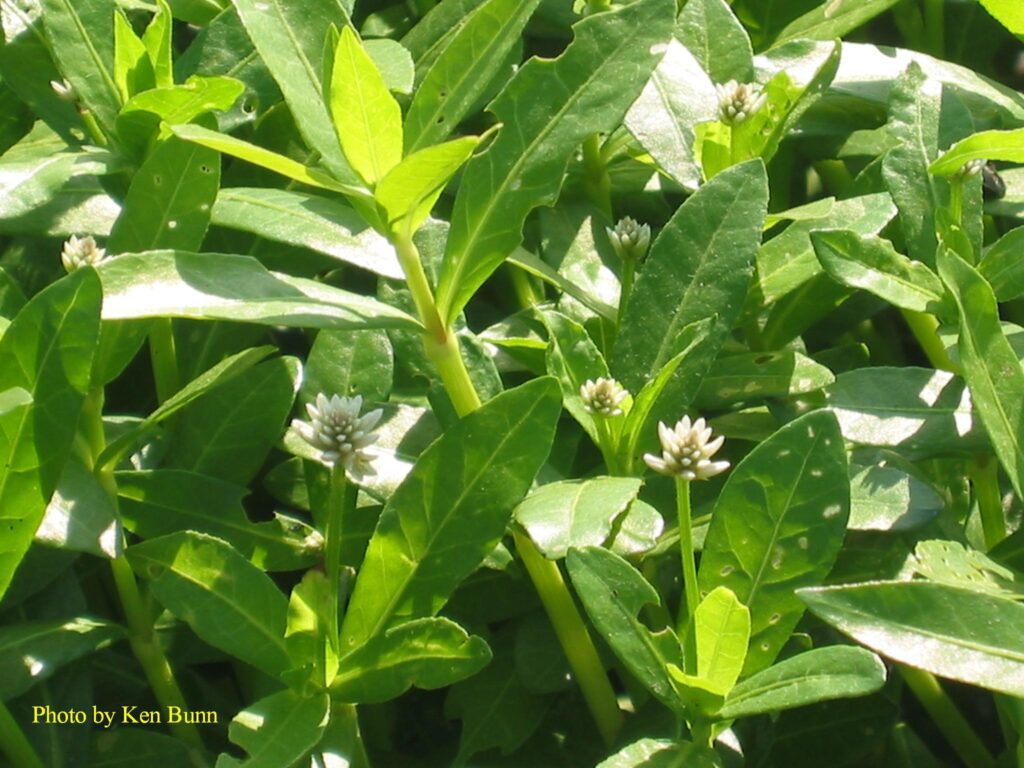
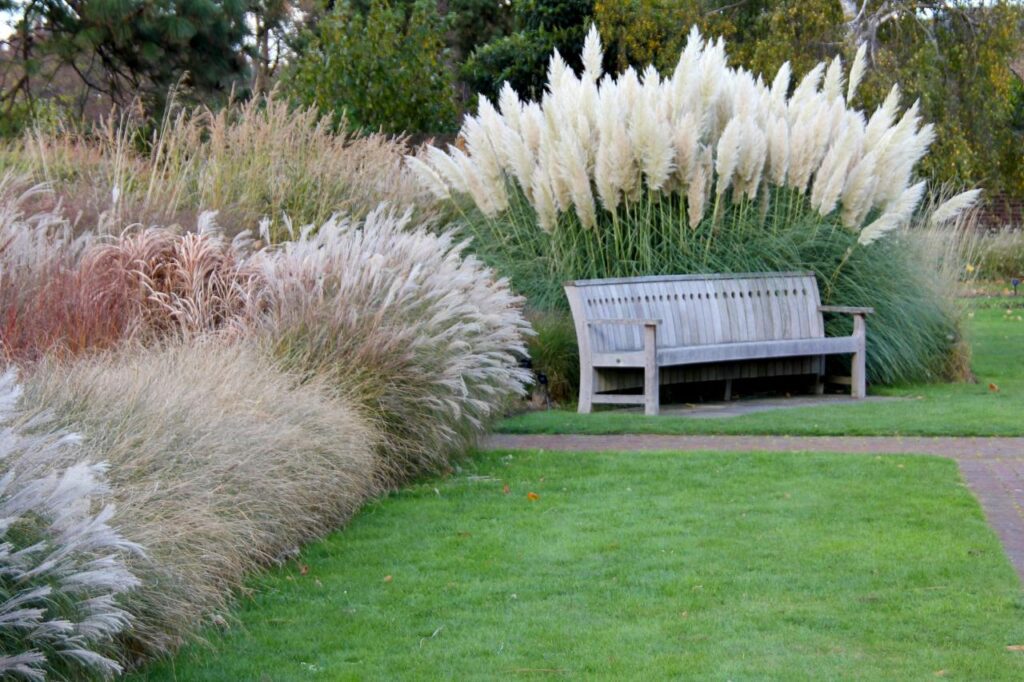
Pampas Grass (Cortaderia species): An introduced ornamental grass that can become invasive and outcompete native vegetation.
Please note that this list is not exhaustive, and there are several other invasive weed species found in Australia. Authorities and conservationists work to manage and control the spread of these invasive plants to protect native ecosystems and agricultural land.
Now, when I went out looking for weeds, I found these ten plants and more below:
1- Hairy Bittercress (Cardamine hirsuta) is a small annual weed that belongs to the mustard family (Brassicaceae). It is native to Europe and has become naturalized in many other parts of the world, including North America, Australia, and various regions in Asia. The plant is commonly found in gardens, lawns, cultivated fields, and disturbed areas.
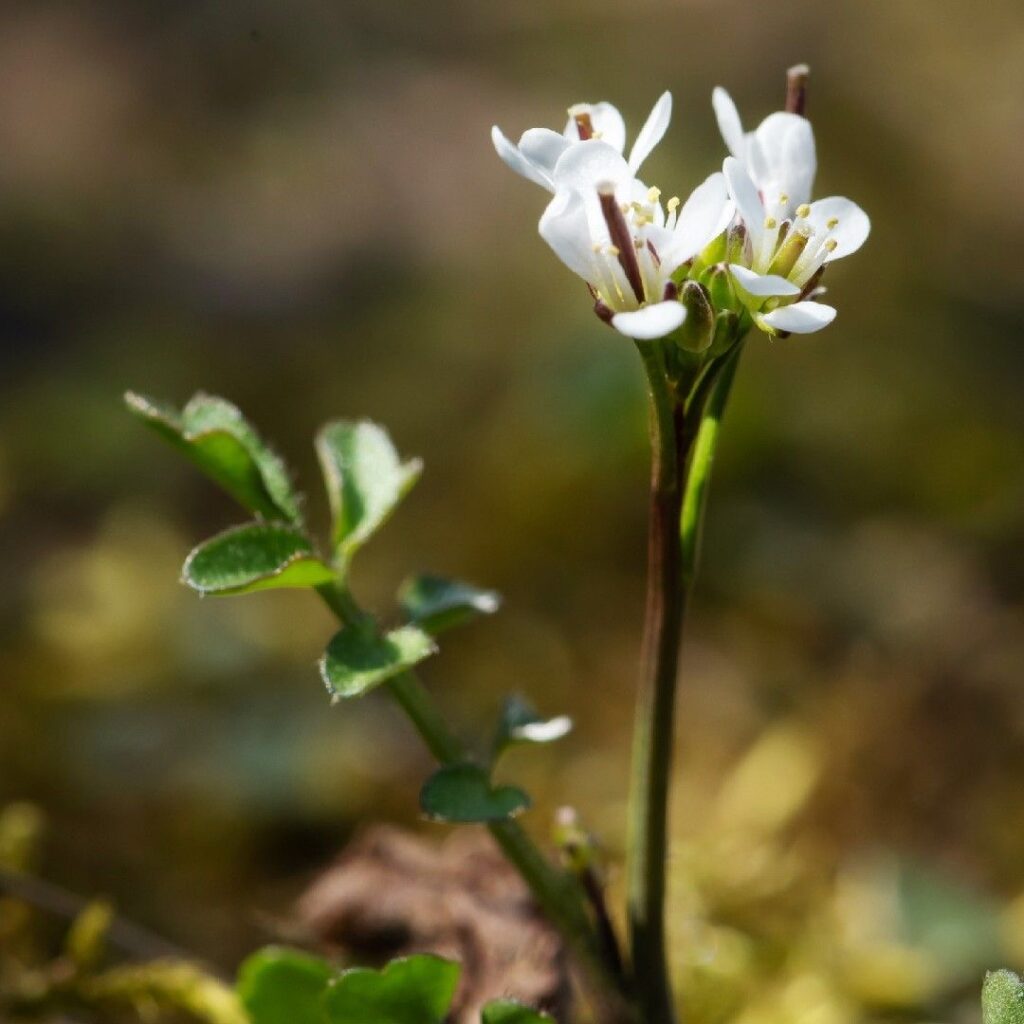
Key characteristics of Hairy Bittercress include:
- Appearance: The plant typically grows up to 20-40 centimeters (8-16 inches) tall. It has small, compound leaves with numerous leaflets that have a slightly hairy texture, hence the name “Hairy Bittercress.” The leaves are arranged in a basal rosette close to the ground.
- Flowers: Hairy Bittercress produces small, white flowers with four petals that form in clusters at the top of the stems. The flowers are usually present from late winter to spring, depending on the region.
- Seed Pods: After flowering, the plant produces slender seed pods (siliques) that contain tiny seeds. When the seed pods mature, they explode when touched or disturbed, forcefully ejecting the seeds several feet away, aiding in the plant’s dispersal.
- Lifecycle: Hairy Bittercress is an annual plant, meaning it completes its life cycle within a year. It germinates from seeds in the fall or early spring, grows throughout the winter, flowers in spring, produces seeds, and then dies off as temperatures rise in the summer.
- Growth Habit: It is a fast-growing and prolific weed that can quickly colonize bare or disturbed soil, often forming dense patches.
Control and Management:
Hairy Bittercress can be an annoyance in gardens and lawns due to its rapid growth and the explosive dispersal of its seeds, which can lead to new infestations. Some management practices to control Hairy Bittercress include:
- Hand-pulling: For small infestations, the weed can be manually pulled, ensuring the entire plant, including its root system, is removed.
- Mulching: Applying a layer of organic mulch can help suppress weed growth and prevent seeds from reaching the soil.
- Mowing: Regular mowing in lawns can help prevent the weed from flowering and producing seeds.
- Pre-emergent Herbicides: In some cases, pre-emergent herbicides can be used to prevent Hairy Bittercress seeds from germinating in the first place.
As with any weed control strategy, it is crucial to be mindful of the environment and use appropriate and safe practices to minimize harm to desired plants and wildlife. Always read and follow the instructions on herbicide labels carefully
2- Common Sowthistle, scientifically known as Sonchus oleraceus, is a widespread annual weed belonging to the Asteraceae family. It is native to Europe and has become naturalized in many other parts of the world, including North America, Australia, and Asia. Common Sowthistle is often found in disturbed areas, gardens, lawns, agricultural fields, and along roadsides.
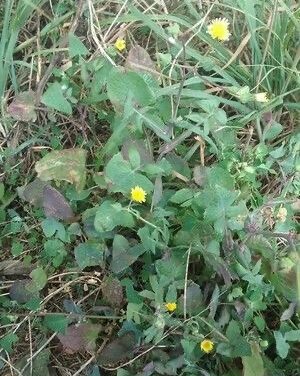
Key characteristics of Common Sowthistle include:
- Appearance: The plant typically grows between 30 to 150 centimeters (12 to 59 inches) tall. It has bright green, lobed leaves that often have irregular, sharp-toothed margins. The leaves can be hairy or smooth, depending on the variety.
- Flowers: Common Sowthistle produces yellow, dandelion-like flowers with multiple ray florets surrounding a central disk. The flowers are arranged in clusters at the top of the stems and have a similar appearance to dandelion flowers.
- Seed Production: After flowering, the plant produces fluffy white seeds with feathery bristles, which aid in wind dispersal.
- Lifecycle: Common Sowthistle is an annual plant, completing its life cycle within a year. It germinates from seeds in the fall or early spring, grows throughout the winter and spring, flowers in late spring to early summer, produces seeds, and then dies off as temperatures rise in the summer.
- Growth Habit: It is a rapid-growing weed and can quickly colonize disturbed areas, competing with other plants for resources.
Control and Management:
Managing Common Sowthistle can be important in agricultural settings and gardens to prevent its spread and competition with desired plants. Some control methods include:
- Cultural Practices: Maintaining healthy and dense vegetation in lawns and gardens can help suppress weed growth, including Common Sowthistle.
- Hand-pulling: For small infestations, the weed can be manually removed by uprooting the entire plant, including its root system.
- Mowing: Regular mowing can prevent the weed from flowering and producing seeds.
- Herbicides: Selective herbicides can be used to control Common Sowthistle in agricultural settings or when other methods are not feasible.
3- Smooth Hawksbeard, scientifically known as Crepis capillaris, is a common annual or biennial weed belonging to the Asteraceae family. It is native to Europe but has become naturalized in many other parts of the world, including North America, Australia, and Asia. Smooth Hawksbeard is often found in disturbed areas, gardens, lawns, agricultural fields, and along roadsides.
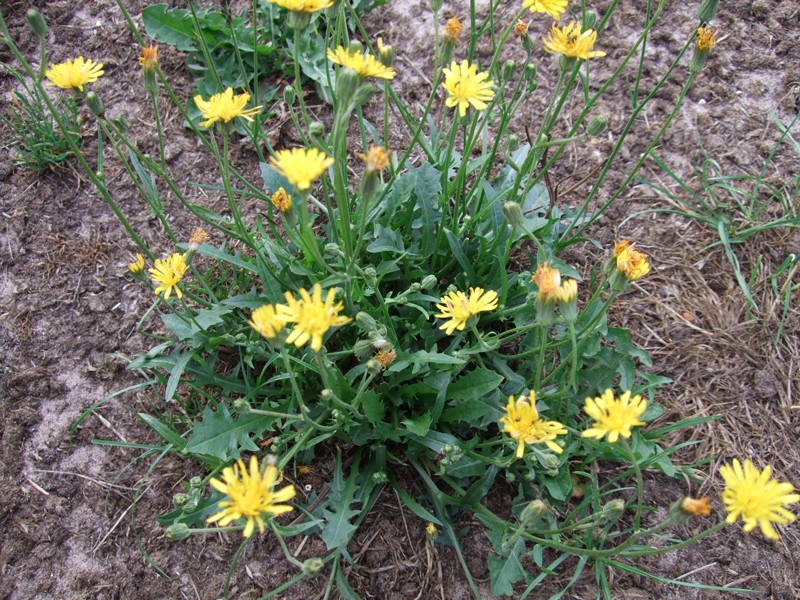
Key characteristics of Smooth Hawksbeard include:
- Appearance: The plant typically grows between 20 to 80 centimeters (8 to 31 inches) tall. It has slender, erect stems and narrow, lance-shaped leaves with toothed or slightly lobed edges. The leaves are smooth, lacking hairs or bristles.
- Flowers: Smooth Hawksbeard produces small, yellow flowers that have a dandelion-like appearance. The flowers have multiple ray florets surrounding a central disk and are arranged in clusters at the top of the stems.
- Seed Production: After flowering, the plant produces seeds with a feathery pappus, aiding in wind dispersal. The seeds are similar to those of dandelions and can be easily carried by the wind to new locations.
- Lifecycle: Smooth Hawksbeard can act as both an annual and biennial plant. As an annual, it completes its life cycle within a year, while as a biennial, it requires two years to complete its life cycle. It germinates from seeds in the fall or early spring, grows throughout the winter and spring, flowers in late spring to early summer, produces seeds, and then dies off as temperatures rise in the summer.
- Growth Habit: It is a competitive and prolific weed, capable of rapidly colonizing disturbed areas and competing with other plants for resources.
Control and Management:
Managing Smooth Hawksbeard is essential in agricultural settings and gardens to prevent its spread and competition with desired plants. Some control methods include:
- Cultural Practices: Maintaining healthy and dense vegetation in lawns and gardens can help suppress weed growth, including Smooth Hawksbeard.
- Hand-pulling: For small infestations, the weed can be manually removed by uprooting the entire plant, including its root system.
- Mowing: Regular mowing can prevent the weed from flowering and producing seeds.
- Herbicides: Selective herbicides can be used to control Smooth Hawksbeard in agricultural settings or when other methods are not feasible.
4- Dandelion, scientifically known as Taraxacum officinale, is a familiar and widespread flowering plant that belongs to the Asteraceae family. Despite being considered a weed by some, dandelions are well-known for their bright yellow flowers and distinctive fluffy seed heads. Dandelions are native to Europe and Asia but have become naturalized in many parts of the world, including North America and Australia.
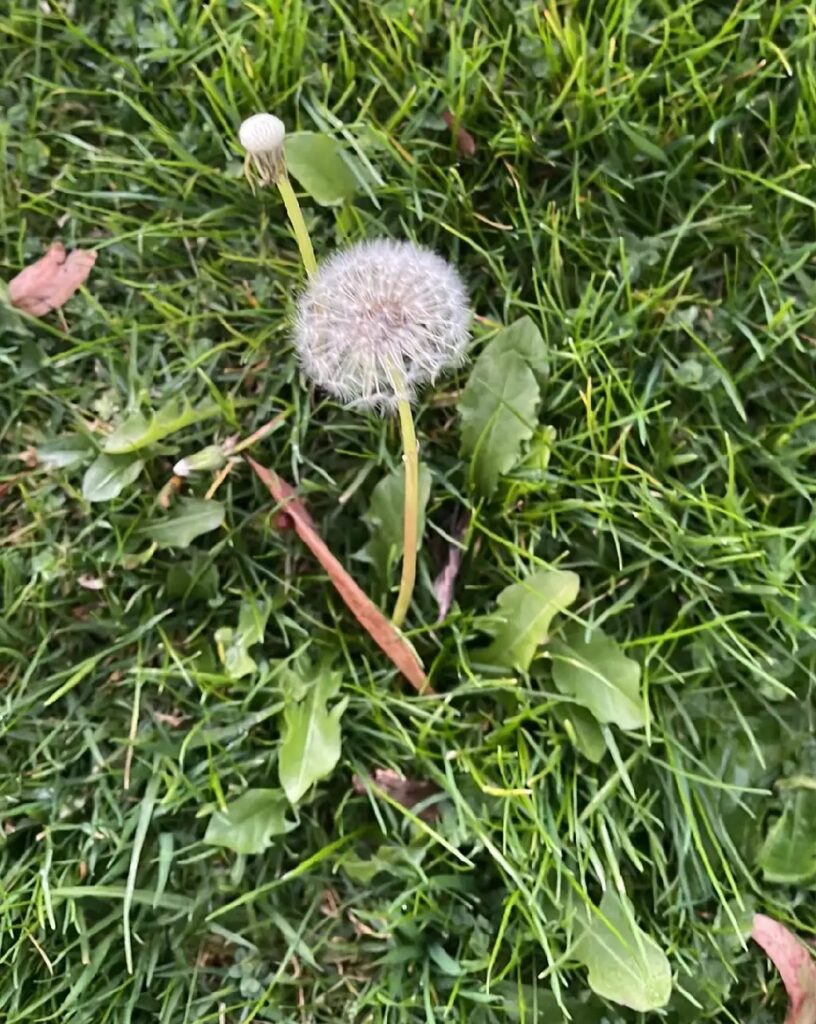
Key characteristics of dandelions include:
- Appearance: Dandelions typically have a basal rosette of deeply toothed, lance-shaped leaves that grow directly from the ground. The leaves are hairless and can vary in size and shape, with some being more lobed than others. The leaves and stems exude a milky, white sap when broken.
- Flowers: Dandelions produce bright yellow composite flowers, consisting of numerous tiny ray florets arranged in a dense, rounded head. These flowers can be 2 to 5 centimeters (0.8 to 2 inches) in diameter and are borne on hollow stems that rise from the center of the rosette.
- Seed Production: After the flowers are pollinated, they turn into spherical seed heads called “dandelion clocks” or “blowballs.” Each seed head is composed of numerous small, fluffy achenes with attached parachutes (pappus) that enable them to disperse easily in the wind.
- Lifecycle: Dandelions are perennial plants, meaning they can live for several years. They reproduce primarily by seeds, but they also have a deep taproot that allows them to regrow after the above-ground parts are cut or damaged.
- Culinary and Medicinal Uses: Dandelions have a long history of culinary and medicinal uses. Young leaves can be consumed in salads or cooked as a vegetable, while the flowers can be used to make dandelion wine or herbal teas. The plant is believed to have various health benefits and is used in traditional medicine for digestive and liver health.
Control and Management:
While some people appreciate dandelions for their bright appearance and potential culinary uses, they can be considered invasive and unwanted in lawns and gardens. Managing dandelions can be challenging due to their ability to spread rapidly through wind-dispersed seeds and their regenerative taproots. Some control methods include:
- Hand-pulling: For small infestations, dandelions can be manually removed, ensuring the entire taproot is extracted to prevent regrowth.
- Mowing: Regular mowing can prevent dandelions from flowering and producing seeds.
- Herbicides: Selective herbicides specifically designed to target broadleaf weeds, such as dandelions, can be used for more extensive infestations
5- White Clover, scientifically known as Trifolium repens, is a common and well-known perennial plant belonging to the Fabaceae (legume) family. It is native to Europe and parts of Asia, but it has been widely introduced and naturalized in many regions across the globe, including North America, Australia, and New Zealand. White Clover is often cultivated as a forage crop for livestock, and it also grows naturally in lawns, meadows, and other open areas.
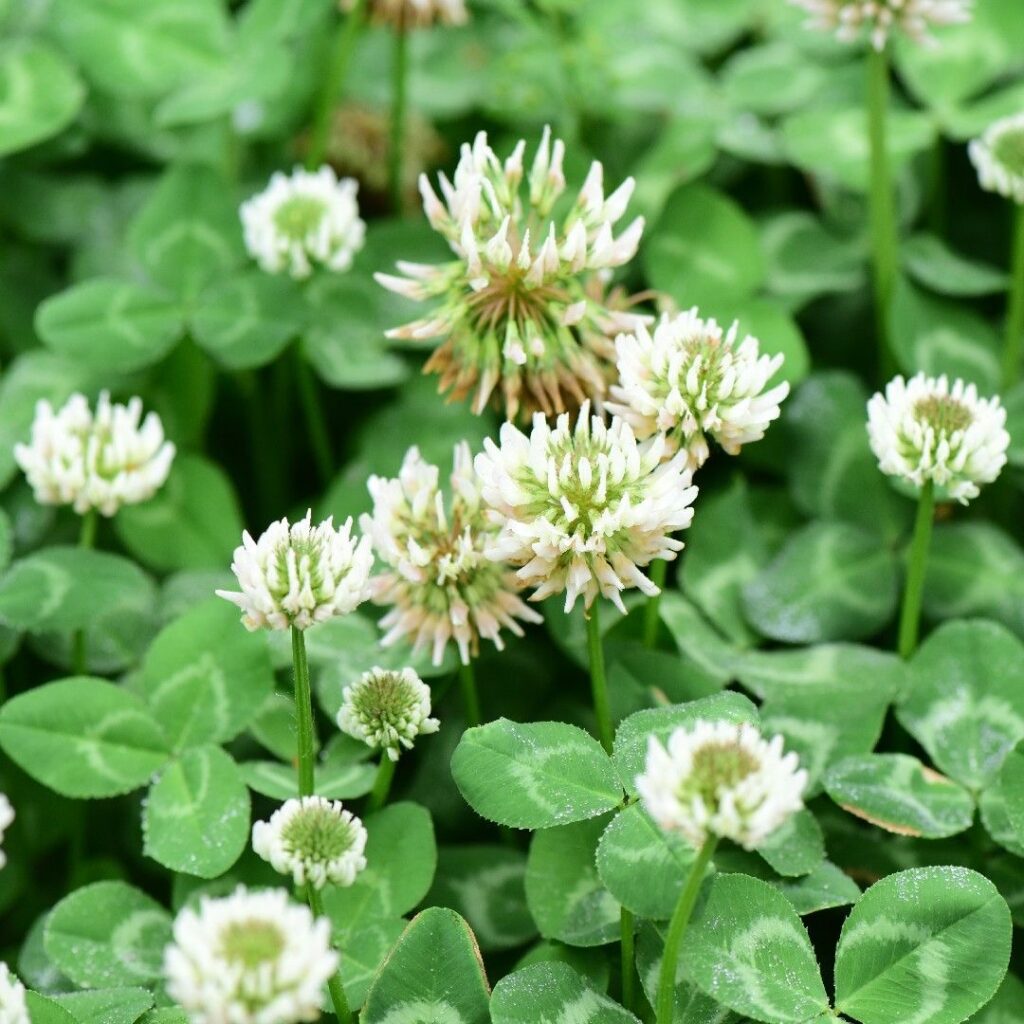
White Clover, scientifically known as Trifolium repens, is a common and well-known perennial plant belonging to the Fabaceae (legume) family. It is native to Europe and parts of Asia, but it has been widely introduced and naturalized in many regions across the globe, including North America, Australia, and New Zealand. White Clover is often cultivated as a forage crop for livestock, and it also grows naturally in lawns, meadows, and other open areas.
Key characteristics of White Clover include:
- Appearance: White Clover has trifoliate leaves, meaning each leaf is composed of three leaflets. The leaves are bright green, with a white crescent-shaped mark on each leaflet. The plant has creeping stems (stolons) that grow horizontally along the ground, helping it spread and form dense patches.
- Flowers: The flowers of White Clover are small, globe-shaped, and arranged in tight clusters at the top of long stems. Each flower head consists of numerous tiny tubular florets that are white to pale pink in color. The flowers are highly attractive to bees and other pollinators.
- Seed Production: After flowering, White Clover produces small, dry, and round seed pods that contain the seeds. These seeds can be dispersed by animals, human activities, or wind.
- Lifecycle: White Clover is a perennial plant, meaning it can live for multiple years. It regrows each spring from the base of the plant and can continue to spread through its stolons and self-seeding.
- Benefits: White Clover is valued for its ability to fix nitrogen from the air into the soil, which helps improve soil fertility and benefit neighboring plants. It is commonly used as a cover crop in agriculture and is also a beneficial component of natural or low-maintenance lawns due to its ability to withstand foot traffic and enrich the soil.
Control and Management:
White Clover can be considered a beneficial plant in certain settings, such as in pastures, where it provides nutritious forage for grazing animals and helps improve soil health. However, in manicured lawns or formal gardens, some people may prefer to manage or control its growth. Control methods include:
- Mowing: Regular mowing can help control White Clover in lawns by preventing it from flowering and producing seeds.
- Hand-pulling: For small infestations, White Clover can be manually removed. Ensure the entire plant, including the stolons, is extracted to minimize regrowth.
- Herbicides: Selective herbicides designed for broadleaf weed control can be used to manage White Clover in lawns and turf areas.
6- Bay Forget-Me-Not is another common name for the plant Myosotis scorpioides, which belongs to the genus Myosotis in the Boraginaceae family. This plant is also known as Water Forget-Me-Not.
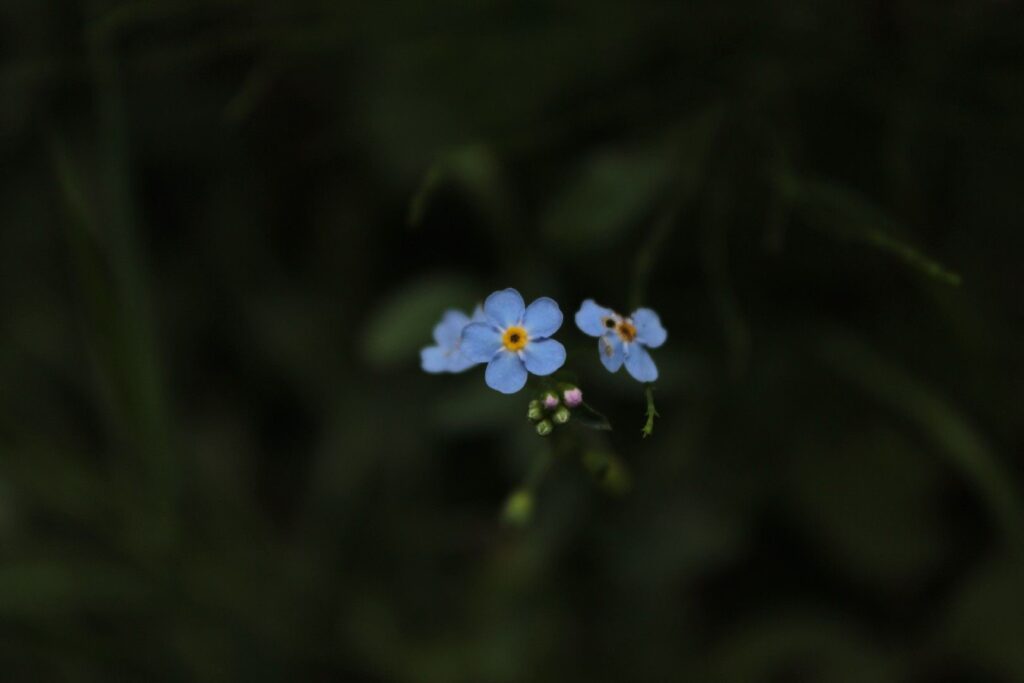
Key characteristics of Bay Forget-Me-Not (Myosotis scorpioides) include:
- Appearance: Bay Forget-Me-Not is a small, herbaceous perennial plant with green, lance-shaped leaves that are often hairy. The leaves grow in a rosette arrangement along the stem.
- Flowers: The plant produces small, five-petaled flowers that are usually blue but can also be pink or white. The flowers have a yellow center and are arranged in clusters at the top of slender, curving stems, resembling a scorpion’s tail (hence the species name “scorpioides”).
- Habitat: Bay Forget-Me-Not is commonly found in wetland areas, such as marshes, stream banks, and the edges of ponds and ditches. It prefers moist and shaded locations.
- Growing Conditions: This plant thrives in cool, temperate climates and prefers soil that is consistently moist. It can tolerate some standing water and shallow flooding.
- Cultural Significance: Forget-Me-Nots, including Bay Forget-Me-Not, are often associated with sentimental value and remembrance. The flowers are commonly used as symbols of friendship and enduring love, and they are frequently given as gifts or used in floral arrangements.
Control and Management:
Bay Forget-Me-Not is generally not considered an invasive weed and is even cultivated in some regions for its ornamental value and habitat benefits in water gardens. However, in certain circumstances, it may grow too aggressively and disrupt native vegetation in wetland areas. In such cases, management strategies can include:
- Thinning: If Bay Forget-Me-Not becomes too dominant in a wetland area, thinning the plants to reduce their density may help other native species thrive.
- Hand Removal: For small infestations, hand-pulling or cutting the plants can be effective, especially when done before they set seed.
- Natural Competition: Promoting the growth of other native wetland plants can help naturally reduce the dominance of Bay Forget-Me-Not.
- Herbicides: In severe cases, targeted herbicides may be used, but it is crucial to follow best practices to avoid harming non-target species and the surrounding environment.
7- Prickly Lettuce, scientifically known as Lactuca serriola, is a biennial or perennial herbaceous plant that belongs to the Asteraceae family. It is native to Europe and Western Asia but has become naturalized in many parts of North America, Australia, and other regions around the world. Prickly Lettuce is often considered a weed and is commonly found in disturbed areas, agricultural fields, roadsides, and waste places.

Prickly Lettuce, scientifically known as Lactuca serriola, is a biennial or perennial herbaceous plant that belongs to the Asteraceae family. It is native to Europe and Western Asia but has become naturalized in many parts of North America, Australia, and other regions around the world. Prickly Lettuce is often considered a weed and is commonly found in disturbed areas, agricultural fields, roadsides, and waste places.
Key characteristics of Prickly Lettuce include:
- Appearance: Prickly Lettuce has a rosette of deeply lobed leaves with prominent spines along the leaf margins and midrib. The leaves are green and covered with fine hairs, giving them a somewhat prickly or rough texture, hence the name “Prickly Lettuce.”
- Flowers: The plant produces bright yellow flowers with multiple ray florets surrounding a central disk. The flowers are arranged in clusters at the ends of tall, branching stems. They have a similar appearance to other plants in the lettuce family.
- Seed Production: After flowering, Prickly Lettuce produces small, dry, and slender seed heads containing numerous tiny seeds with attached bristles that aid in wind dispersal.
- Lifecycle: Prickly Lettuce can act as both a biennial and a perennial plant. As a biennial, it completes its life cycle in two years, while as a perennial, it can live for multiple years. It germinates from seeds in the fall or early spring, grows as a rosette during its first year, flowers and produces seeds in the second year, and then may die off or continue to grow as a perennial.
- Growth Habit: It is a competitive and prolific weed, capable of rapidly colonizing disturbed areas and outcompeting other plants.
Control and Management:
Prickly Lettuce can be considered an invasive weed in certain settings and can be challenging to control due to its ability to spread rapidly through wind-dispersed seeds and its regenerative taproot. Some control methods include:
- Hand-pulling: For small infestations, Prickly Lettuce can be manually removed by uprooting the entire plant, including its taproot.
- Mowing: Regular mowing can prevent Prickly Lettuce from flowering and producing seeds.
- Herbicides: Selective herbicides designed for broadleaf weed control can be used to manage Prickly Lettuce in agricultural settings or when other methods are not feasible.
8- Petty Spurge, scientifically known as Euphorbia peplus, is an annual herbaceous plant that belongs to the Euphorbiaceae family. It is native to Europe and North Africa but has become naturalized in various regions around the world, including North America, Australia, and parts of Asia. Petty Spurge is considered an invasive weed and is commonly found in gardens, lawns, agricultural fields, and disturbed areas.
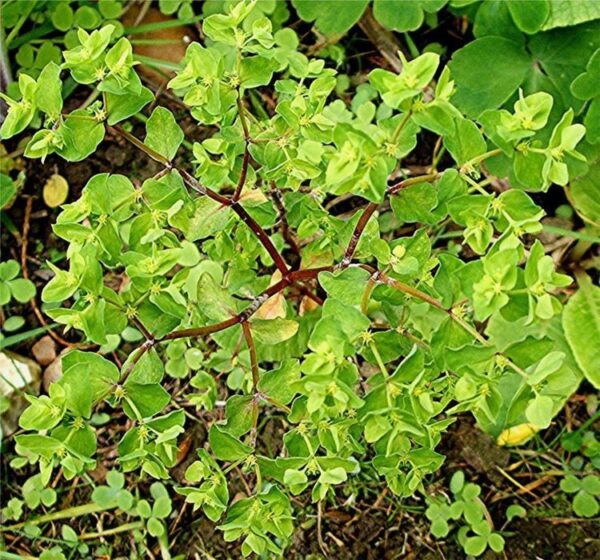
Key characteristics of Petty Spurge include:
- Appearance: Petty Spurge is a small, prostrate plant, meaning it grows close to the ground and spreads outward. It has bright green, succulent-like leaves that are oblong or oval in shape and arranged alternately along the stems. The stems are often reddish or purplish in color.
- Flowers: The plant produces small, inconspicuous flowers that are clustered together in tiny structures called cyathia. These cyathia are surrounded by showy, petal-like bracts, which are usually pale green or yellow with red or purple markings.
- Latex: Petty Spurge exudes a white, milky latex when any part of the plant is broken or cut. This latex can cause skin irritation in some individuals, so handling the plant with care is advisable.
- Seed Production: After flowering, Petty Spurge produces small, three-lobed seed capsules that contain the seeds. When the capsules ripen, they explode, dispersing the seeds over a wide area.
- Lifecycle: Petty Spurge is an annual plant, completing its life cycle within a year. It germinates from seeds in the spring, grows throughout the summer, flowers, produces seeds, and then dies off with the onset of winter.
Control and Management:
Managing Petty Spurge is important in gardens, lawns, and agricultural settings, as it can compete with desired plants and spread rapidly through its abundant seed production. Some control methods include:
- Hand-pulling: For small infestations, Petty Spurge can be manually removed, ensuring the entire plant, including its root system, is extracted.
- Mulching: Applying a layer of organic mulch can help suppress weed growth and prevent Petty Spurge seeds from reaching the soil.
- Herbicides: Selective herbicides designed for broadleaf weed control can be used to manage Petty Spurge in lawns, gardens, and agricultural areas.
9- Horseweed, scientifically known as Conyza canadensis, is an annual weed belonging to the Asteraceae family. It is native to North America but has become widespread and naturalized in many other regions around the world, including Europe, Asia, and Australia. Horseweed is known by various other common names, including mare’s tail, Canadian fleabane, and butterweed.
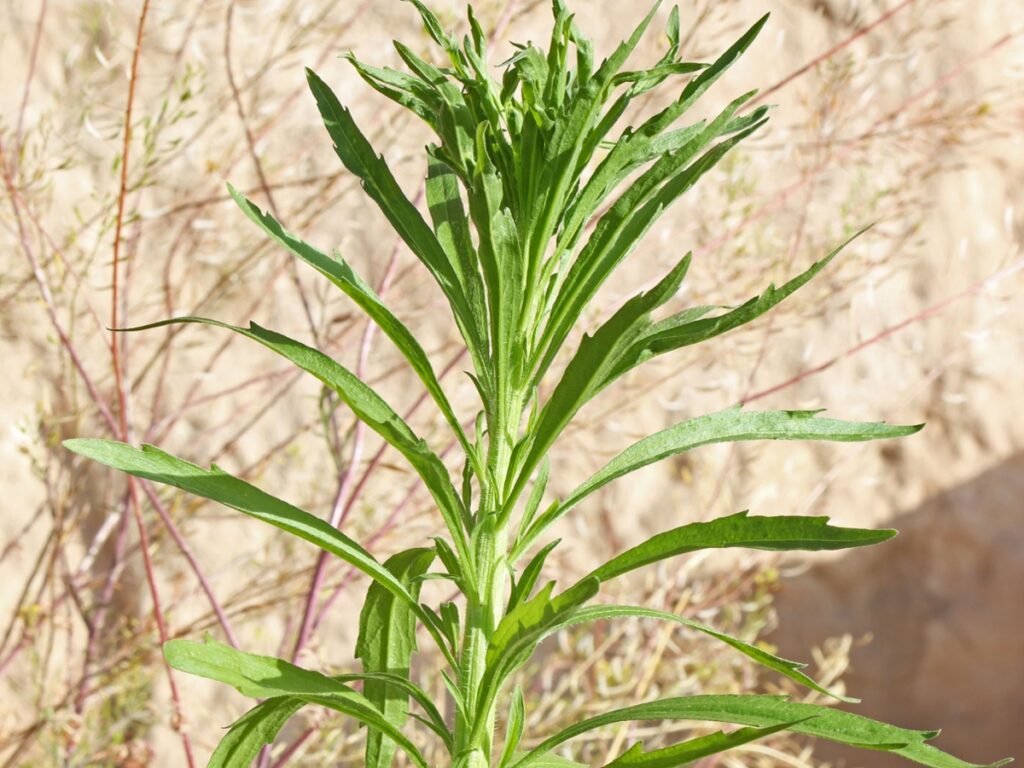
Key characteristics of Horseweed include:
- Appearance: Horseweed is a tall, slender plant that can grow up to 1 to 2 meters (3 to 6 feet) in height. It has a single, erect stem covered in fine hairs. The leaves are lance-shaped, serrated along the edges, and arranged alternately along the stem. The lower leaves are larger and have petioles, while the upper leaves are smaller and clasping the stem.
- Flowers: The plant produces small, white to pale pink flowers with numerous ray florets surrounding a central disk. The flowers are arranged in clusters at the top of the stem.
- Seed Production: After flowering, Horseweed produces numerous tiny seeds with attached bristles (pappus) that aid in wind dispersal. The plant can produce an extensive number of seeds, contributing to its ability to spread rapidly.
- Lifecycle: Horseweed is an annual plant, completing its life cycle within a year. It germinates from seeds in the spring, grows throughout the summer, flowers, produces seeds, and then dies off with the onset of winter.
- Habitat: Horseweed is commonly found in disturbed areas, agricultural fields, gardens, roadsides, and waste places. It can tolerate a wide range of soil types and environmental conditions.
Control and Management:
Horseweed can be a challenging weed to control due to its prolific seed production and ability to germinate at various times throughout the year. Effective management strategies include:
- Early Control: Addressing Horseweed infestations early in the growing season is crucial to preventing further spread and seed production.
- Herbicides: Selective herbicides designed for broadleaf weed control can be used to manage Horseweed in agricultural settings and non-crop areas.
- Cultural Practices: Maintaining healthy and dense vegetation in lawns, gardens, and agricultural fields can help suppress weed growth, including Horseweed.
- Tillage: In agricultural settings, tillage practices can help manage Horseweed by disrupting its growth and burying the seeds, reducing their viability.
10- Perennial Wall-Rocket, scientifically known as Diplotaxis tenuifolia, is a herbaceous perennial plant in the Brassicaceae family. It is native to Europe and is commonly found in various parts of the world, including North America, Australia, and parts of Asia. Perennial Wall-Rocket is often considered a weed and is typically found in disturbed areas, roadsides, gardens, and waste places.

Key characteristics of Perennial Wall-Rocket include:
- Appearance: Perennial Wall-Rocket has deeply lobed, pinnately divided leaves that are green and somewhat fleshy. The leaves are arranged alternately along the stem. The plant forms a rosette close to the ground and can grow upright stems as it matures.
- Flowers: The plant produces small, pale yellow flowers with four petals. The flowers are borne in elongated racemes and can be seen throughout the growing season.
- Habitat: Perennial Wall-Rocket thrives in sunny locations with well-draining soil. It is often found growing on walls, pavements, cracks in sidewalks, and other urban or disturbed environments.
- Lifecycle: As the name suggests, Perennial Wall-Rocket is a perennial plant, meaning it can live for multiple years. It regrows each year from the base of the plant and can continue to spread through its prolific seed production.
- Seed Production: After flowering, Perennial Wall-Rocket produces small, elongated seed pods that contain numerous seeds. These seed pods can split open when ripe, releasing the seeds in the surrounding area.
Control and Management:
Managing Perennial Wall-Rocket can be challenging due to its ability to spread through both vegetative growth and abundant seed production. Some control methods include:
- Hand-pulling: For small infestations, Perennial Wall-Rocket can be manually removed, ensuring the entire plant, including its taproot, is extracted.
- Mulching: Applying a layer of organic mulch can help suppress weed growth and prevent Perennial Wall-Rocket seeds from reaching the soil.
- Herbicides: Selective herbicides designed for broadleaf weed control can be used to manage Perennial Wall-Rocket in gardens and non-crop areas.
- Prevention: Preventing the establishment of Perennial Wall-Rocket through regular weeding and maintaining healthy vegetation in gardens and lawns can help reduce its spread.
These are only twenty plants out of thousands, as of September 2021, Australia is home to numerous weed species, with over 8,000 introduced plants listed as invasive or naturalized. The exact number of reported weeds may vary over time due to ongoing research, the discovery of new species, and changes in plant distributions.
The Australian government and various organizations continually monitor and update lists of invasive and naturalized plants. These lists help in understanding the extent of the weed problem, implementing control measures, and protecting native ecosystems from the negative impacts of invasive species.
For the most up-to-date and accurate information on the number of reported weeds in Australia, it’s best to refer to official sources such as government departments responsible for agriculture, environment, and biosecurity, as well as scientific publications and research databases such as https://weeds.org.au.
In the end, it’s important to remind everyone about the dangers of using chemicals to deal with weeds as it can pose several dangers and risks, which include:
- Environmental Impact: Some herbicides can be toxic to non-target plants and animals, leading to unintended harm to beneficial insects, birds, and wildlife. Additionally, herbicides can leach into soil and water, potentially contaminating natural habitats and water bodies.
- Herbicide Resistance: Frequent and overreliance on certain herbicides can lead to the development of herbicide-resistant weed populations. This means that the chemicals become less effective over time, making weed control more challenging and costly.
- Human Health Concerns: Improper handling or exposure to herbicides can pose health risks to humans. Some herbicides may cause skin irritation, respiratory issues, or more severe health problems if ingested or inhaled.
- Drift and Runoff: Herbicides can drift away from the target area during application, affecting neighboring crops, gardens, and natural areas. Herbicides can also wash off treated surfaces and contaminate nearby water sources through runoff.
- Persistence: Some herbicides can remain active in the soil for extended periods, impacting future plant growth and potentially affecting subsequent crop rotations.
- Non-Target Plant Damage: Non-selective herbicides can harm desirable plants along with weeds, leading to unintended damage to cultivated crops, gardens, or natural vegetation.
- Ecosystem Disruption: Eliminating specific weed species can disrupt the ecological balance and alter food sources and habitats for native wildlife and insects.
To minimize the dangers associated with chemical weed control, it’s crucial to:
- Follow label instructions and recommended application rates when using herbicides.
- Apply herbicides during optimal weather conditions to reduce drift and runoff.
- Consider using selective herbicides that target specific weed species while sparing desirable plants.
- Use integrated weed management approaches that combine chemical control with other methods, such as mechanical, biological, and cultural controls.
- Employ preventive measures, such as weed prevention through good garden and agricultural practices, to reduce the need for chemical control.
Ultimately, the safe and effective use of herbicides requires proper knowledge, training, and adherence to regulations and best practices to protect both human health and the environment.
Thanks for reading and keep growing, ☮️
